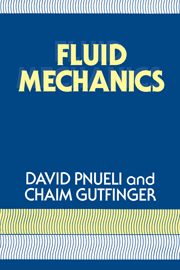Book contents
- Frontmatter
- Contents
- PREFACE
- 1 INTRODUCTION
- 2 STRESS IN A FLUID
- 3 FLUID STATICS
- 4 FLUIDS IN MOTION – INTEGRAL ANALYSIS
- 5 FLUIDS IN MOTION – DIFFERENTIAL ANALYSIS
- 6 EXACT SOLUTIONS OF THE NAVIER–STOKES EQUATIONS
- 7 ENERGY EQUATIONS
- 8 SIMILITUDE AND ORDER OF MAGNITUDE
- 9 FLOWS WITH NEGLIGIBLE ACCELERATION
- 10 HIGH REYNOLDS NUMBER FLOWS – REGIONS FAR FROM SOLID BOUNDARIES
- 11 HIGH REYNOLDS NUMBER FLOWS – THE BOUNDARY LAYER
- 12 TURBULENT FLOW
- 13 COMPRESSIBLE FLOW
- 14 NON-NEWTONIAN FLUIDS
- APPENDIXES
- INDEX
9 - FLOWS WITH NEGLIGIBLE ACCELERATION
Published online by Cambridge University Press: 05 June 2012
- Frontmatter
- Contents
- PREFACE
- 1 INTRODUCTION
- 2 STRESS IN A FLUID
- 3 FLUID STATICS
- 4 FLUIDS IN MOTION – INTEGRAL ANALYSIS
- 5 FLUIDS IN MOTION – DIFFERENTIAL ANALYSIS
- 6 EXACT SOLUTIONS OF THE NAVIER–STOKES EQUATIONS
- 7 ENERGY EQUATIONS
- 8 SIMILITUDE AND ORDER OF MAGNITUDE
- 9 FLOWS WITH NEGLIGIBLE ACCELERATION
- 10 HIGH REYNOLDS NUMBER FLOWS – REGIONS FAR FROM SOLID BOUNDARIES
- 11 HIGH REYNOLDS NUMBER FLOWS – THE BOUNDARY LAYER
- 12 TURBULENT FLOW
- 13 COMPRESSIBLE FLOW
- 14 NON-NEWTONIAN FLUIDS
- APPENDIXES
- INDEX
Summary
The nonlinear terms on the left-hand side of the Navier–Stokes equations result from the acceleration of the fluid. We already know that these terms contribute much to the difficulties one encounters in the solution of the equations. Indeed, we have noted the relative ease with which exact solution have been obtained in Chapter 6 for fully developed flows, where those nonlinear terms vanish. As we now look for approximations, obtained by the solutions of approximate forms of the Navier–Stokes equations, the first idea that comes to mind is to remove the terms which cause the greatest difficulty, i.e., the nonlinear acceleration terms.
Our subject here is fluid mechanics, and in this context we must ask if there exist real flows in which the acceleration terms are negligible; and if they exist, how do we identify them? The answer to this enquiry is that there are at least two such families of flows: flows in narrow gaps and creeping flows.
Flow in Narrow Gaps
Consider the two-dimensional flow of an incompressible fluid in the narrow gap between the two plates shown in Fig. 9.1. For simplicity we assume the plates to be flat. The results obtained in this analysis may be extended to cases where the plates are curved, as long as the gap is much smaller than the radius of curvature. Another possible extension is to three-dimensional flows, where a w-component of the velocity also exists. Here we present the simplest examples of gap flows and limit the analysis to two-dimensional flows between flat plates.
- Type
- Chapter
- Information
- Fluid Mechanics , pp. 277 - 302Publisher: Cambridge University PressPrint publication year: 1992



